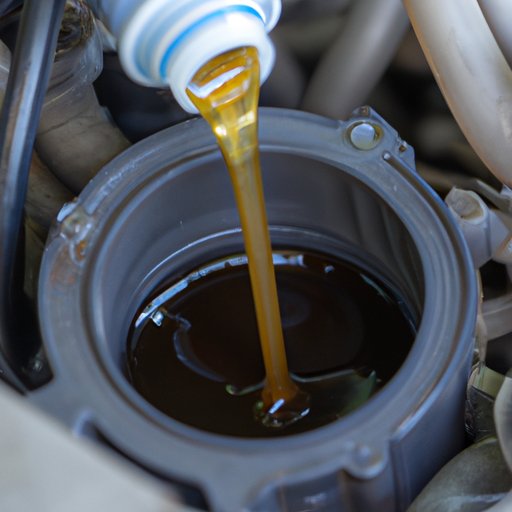
I. Introduction
Adding transmission fluid is an essential part of maintaining your car’s transmission system. This article provides a detailed guide on how to add transmission fluid to your vehicle, the importance of regular maintenance, and the benefits of doing so. Whether you are a first-time car owner or a seasoned mechanic, this article is intended to help you maintain and protect your car’s transmission system.
II. Step-by-Step Guide on How to Add Transmission Fluid
Before you start adding transmission fluid, you need to have the necessary tools, including a funnel, a clean rag, and the correct type of transmission fluid required for your car. Here’s a step-by-step guide on how to add transmission fluid to your car:
- Park your car on level ground and engage the parking brake to prevent it from rolling.
- Open the hood and locate the transmission dipstick. It is usually located towards the back of the engine compartment, near the transmission.
- Wipe the dipstick with a clean rag and reinsert it into the transmission.
- Remove the dipstick and check the fluid level. If it is below the recommended level, it’s time to add transmission fluid.
- Place the funnel in the dipstick tube and slowly pour the transmission fluid into the transmission’s reservoir. Be sure not to overfill the system.
- Remove the funnel and reinstall the dipstick. Check the fluid level again to ensure it is within the recommended range.
- Start the engine and let it idle for a few minutes to allow the transmission fluid to circulate throughout the system.
It’s important to follow the manufacturer’s instructions while adding transmission fluid to your car to ensure that you are not damaging your transmission system and to prevent any potential leaks.
III. The Importance of Adding Transmission Fluid
Transmission fluid lubricates the gears of your car’s transmission and helps it to operate efficiently. It also helps to regulate the temperature of the transmission system, preventing it from overheating. Low levels of transmission fluid can cause serious damage to your car’s transmission system and can lead to costly repairs or even transmission failure. A regular check of the transmission fluid level and adding fluid when necessary can help to prevent these issues and maintain the overall health of your car.
IV. Signs That Your Car Needs Transmission Fluid
It’s important to be aware of the signs and symptoms of low transmission fluid levels. Here are some common indicators that your car needs transmission fluid:
- Burning smell coming from your car’s engine
- Noise or humming sound when driving across different gears
- Difficulty shifting gears
- Slipping gears
- Transmission fluid leaks
Early detection of these signs can save you from significant repair costs in the future. So, keep a check on your transmission fluid levels and take action as soon as you notice any of these symptoms.
V. Different Types of Transmission Fluid
There are several types of transmission fluid available in the market, including synthetic, mineral-based, and semi-synthetic. Choosing the right type of transmission fluid for your vehicle can help to ensure optimal performance, fuel economy, and longevity of your car’s transmission system. Here is a brief overview of the different types of transmission fluid:
- Synthetic transmission fluid: These fluids provide smoother shifting and improved fuel efficiency.
- Mineral-based transmission fluid: These fluids are the most common type and are suitable for most cars.
- Semi-synthetic transmission fluid: These fluids are a mix of synthetic and mineral-based fluids and provide the benefits of both.
It is essential to read your car’s owner’s manual to determine the correct type of transmission fluid required for your vehicle. Choosing the wrong type of fluid can lead to poor performance and potential transmission damage.
VI. The Cost of Adding Transmission Fluid: How to Save Money
The cost of adding transmission fluid can vary based on the type of fluid and the service charges. However, adding transmission fluid can save you from significant expenses in the future. Here are some tips to help you save money while adding transmission fluid:
- Become knowledgeable about the type of transmission fluid needed for your vehicle: This way, you can save money by buying fluid in bulk.
- Do it yourself: You can save money by adding transmission fluid yourself instead of getting it done by a professional service.
- Regular maintenance: Regular transmission fluid changes can help to prevent transmission issues that can lead to costly repairs.
VII. Conclusion
Adding transmission fluid is an essential part of maintaining your car’s transmission system. Regular checks of transmission fluid levels and adding fluids when necessary can help to prevent major issues and costly repairs in the future. As a responsible car owner, it is our duty to take care of our car’s transmission system. So, follow the outlined steps, keep a check on the symptoms, choose the right type of fluid, and save money by doing it yourself. Taking these simple steps can help maintain the health of your car’s transmission system and save you from significant expenses in the future.




